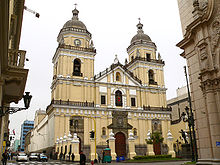Jirón Azángaro
 | |
| Part of | Damero de Pizarro |
|---|---|
| Namesake | Azángaro Province |
| From | Jirón Áncash |
| Major junctions | Junín, Huallaga, Ucayali, Santa Rosa, Cuzco, Puno, Apurímac, La Colmena, Av. Roosevelt |
| To | Jirón Manuel Aljovín |
| Construction | |
| Completion | 1535 |
Jirón Azángaro is a major street in the Damero de Pizarro, located in the historic centre of Lima, Peru. The street starts at its intersection with the Jirón Áncash and continues until it reaches Jirón Manuel Aljovín, next to the Palace of Justice.
It is home to a number of government buildings, such as the Casa de Pilatos (headquarters of the Constitutional Court of Peru), and also houses restaurants and pastry shops.[1]
History
[edit]The road that today constitutes the street was laid by Francisco Pizarro when he founded the city of Lima on January 18, 1535. In the 16th century, the Church of San Francisco was built. In 1862, when a new urban nomenclature was adopted, the road was named jirón Azángaro, after Azángaro Province. Prior to this renaming, each block (cuadra) had a unique name:
- Block 1: Aparicio, after the surname of either Lorenzo José or Manuel Martínez de Aparicio.[2]
- Block 2: Aldabas, after a house with peculiar door knockers (Spanish: aldabas), their peculiarness being a sign that other knockers around the city were manufactured there.[3]
- Block 3: Beytia, after the street's inhabitants of the same name.[4]
- Block 4: Gato, after oidor Francisco Alvárez Gato, who lived there.[5]
- Block 5: Negreyros, after the noble family of the same name, who lived there.[6]
- Block 6: Juan Pablo, after a neighbour of the same name, possibly Juan Pablo Messía, according to Luis A. Eguiguren.[7]
- Block 7: Huérfanos, after the church of the same name.[8]
- Block 8: San Carlos.[9]
- Block 9: Noviciado, after the novitiate of Saint Anthony the Abbot, located there.[6]
- Block 10: Guadalupe, after the church of the same name. Once the adjacent school was suppressed, it became a prison; both buildings were ultimately demolished to build the Palace of Justice.[10]
- Block 11: Buenaventura, after the Franciscan school of the same name.[11]
The art deco-style Gildemeister Building was built from 1927 to 1928, becoming one of the first five-storey buildings of the city, and the most representative of its time. It was named after Gildemeister y Cía., a German sugar company that operated in the Casa Grande hacienda of La Libertad.[12]
Also located in the street is the 1,500 m2 Casa Elguera, built c. 1862–1865 and located in the former Aldabas street, in the corner with Santa Rosa. Originally bought by Francisco Tamayo de Mendoza y Navarra, Marquis of Villahermosa de San José, in 1690, its current construction dates from the mid-19th century, built by landowner Buenaventura Elguera.[12]
The republican Finca de la calle de Aldabas, located in the former streets of Santa Apolonia and Melchormalo, was the property of the Monastery of the Conception, sold to Ana Inclán in 1747. After her death, the Marquis of Villa Blanca, Antonio de Mena, acquired it in 1778. The convent owned the property until 1862, when the Peruvian State acquired it.[12]
In 2014 and 2015, a number of police raids took place on the street where counterfeit documents were forged by criminals.[13][14][15] As of 2023, said businesses continued to operate, selling false residence permits to foreigners in Peru.[16]
See also
[edit]References
[edit]- ^ Centro de Lima: conozca la historia desconocida del jirón Azángaro (Motion picture) (in Spanish). Panamericana Televisión. 2021-06-04.
- ^ Bromley Seminario 2019, p. 187–188.
- ^ Bromley Seminario 2019, p. 177–180.
- ^ Bromley Seminario 2019, p. 207–208.
- ^ Bromley Seminario 2019, p. 267–268.
- ^ a b Bromley Seminario 2019, p. 323–327.
- ^ Bromley Seminario 2019, p. 280–281.
- ^ Bromley Seminario 2019, p. 272–273.
- ^ Bromley Seminario 2019, p. 149.
- ^ Bromley Seminario 2019, p. 269–270.
- ^ Bromley Seminario 2019, p. 215.
- ^ a b c Planas, Enrique. "Las casonas del Centro de Lima". El Comercio.
- ^ "Incautaron cientos de documentos falsos en el jirón Azángaro". El Comercio. 2014-08-01.
- ^ "Así fue la operación 'Rescatando el jirón Azángaro'". El Comercio. 2014-08-01.
- ^ "Operativo policial en el jirón Azángaro dejó siete intervenidos". Canal N. 2015-08-10.
- ^ McCubbin, Ricardo (2023-10-22). "Extranjeros en Lima caen en manos de mafias que ofrecen carnets de permanencia falsos". Infobae.
Bibliography
[edit]- Bromley Seminario, Juan (2019). Las viejas calles de Lima (PDF) (in Spanish). Lima: Metropolitan Municipality of Lima.
